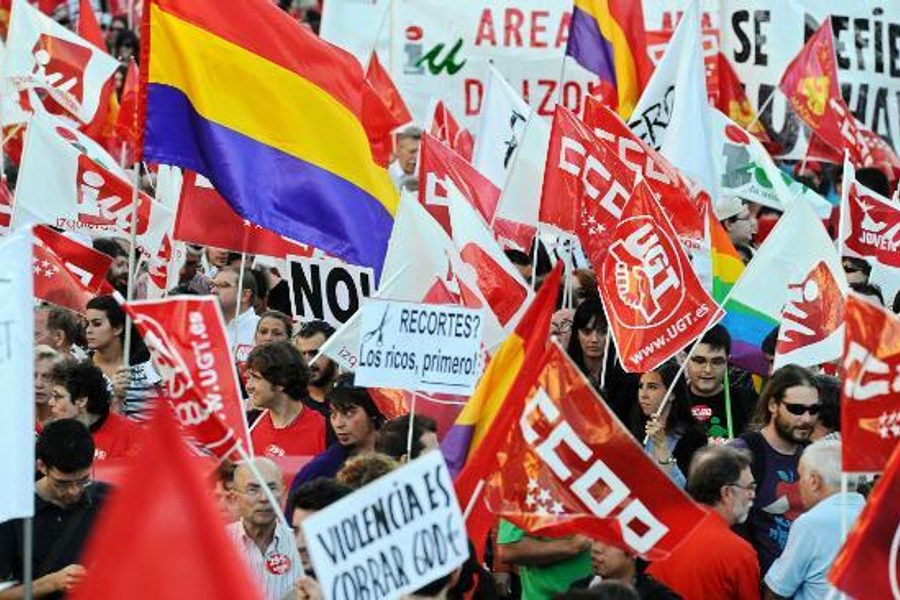
The idea of American Exceptionalism has loomed large over the last half century, creating an air of national impunity while spreading a neoliberal capitalist model to every corner of the globe. Now the Great Recession has revealed American workers to be exceptional in the worst possible way: facing exceptional pain and exceptional weakness in the labor movement.
A report published by the International Trade Union Confederation (submitted, ironically, to that pillar of the postwar American hegemony, the World Trade Organization) takes a critical view of the U.S. workforce in the context of global human and labor rights. The ITUC’s findings expose many of the cracks in the American Way, from a persistent gender wage gap to a failure to uphold child labor protections to a disturbing prevalence of human trafficking. One of the key systemic problems is the institutional weakness of the labor movement:
U.S. law excludes large groups of workers from the right to organise. These include agricultural workers, many public sector workers, domestic workers, supervisors and independent contractors. Moreover, for most private sector workers forming trade unions is extremely difficult and anti-union pressure from employers is frequent. The report notes that there is a $4 billion union-busting industry which aims at undermining trade union organising.
The U.S. worker certainly stands apart from her compatriots across the Atlantic. They’re the ones in the news, mobilizing against the harsh austerity plans governments are imposing in response to an exceptional American export: the global economic crisis.
This week, worker demonstrations in France, England, Greece and other besieged economies rocked the continent with an old-school militancy seldom seen in the “developed” world and virtually unheard of in American communities.
In France, transit workers paralyzed the country’s railways to show aggressive opposition to a proposed increase in the standard retirement age by two years. London’s Tube went into a deep freeze on Tuesday, part of a timed-release chaos plan to strike at numerous points during the fall.
Greek truck drivers stopped traffic too, feeding into several days of protest in opposition to proposed anti-labor reforms. Workers countered a wash of teargas by lobbing stones, bottles and tomatoes at police. A day-long strike by healthcare workers left hospitals in disarray. Much of the rage was directed at the potential dismantling of the closed-shop system, which would undermine traditional labor protections and licensing regulations in trades like truck driving.
With plans for a major industrial action by public workers on October 7, the civil-service union ADEDY, Reuters reports, has called on workers to “massively participate in the rallies and demand the termination of all agreements that did away with rights to work and pensions.”
Spain, another blight on the EU’s books, erupted in its first general strike in years this week. Protesters hoped the strike would force the government to confront the political costs of austerity policies. Ignacio Fernandez Toxo, head of the Workers’ Commissions union, told the Associated Press: “The strike was not called to topple the government but it’s up to the government if it wants to stay there.”
Activists in Brussels, meanwhile, stood their ground against riot police and smoke canisters, marching toward the buildings of the European Union as officials contemplated new penalties to impose on member states with swollen deficits.
Depending on how the public reacts to the chaos, the actions could either inspire solidarity or further polarize labor and the political establishment. Either way, unions have upped the ante in the battle against the austerity frenzy.
The U.S. labor movement’s fight for relevancy
Labor on this side of the ocean, however, continues to grapple with its message and mission, barely keeping pace with American-style austerity in the form of the anti-spending, anti-government agenda of Washington’s deficit hawks.
Unions hope to regain some relevance with this weekend’s “One Nation Working Together” rally, which labor is coordinating alongside civil rights, antiwar and environmental groups, among others. The broad, and accordingly vague, agenda centers on “jobs, justice and education.” As Art Levine reports, organizers aspiring to Tea-Party caliber charisma may find that the biggest hurdle at this point is just getting people to show up.
The greater challenge looming over the One Nation campaign isn’t just the optics — it’s defining a weakened movement in an increasingly unstable political arena. And it’s tapping into the public outrage that the right has shrewdly exploited in galvanizing new constituencies. So the groups carrying the “One Nation” banner might want to focus a bit less on projecting an aura of middle-class liberal harmony, and instead learn from the mass appeal of European union militancy.
We’re running into one of the most dangerous aspects of the myth of American Exceptionalism: the concept that American workers somehow operate outside historical class antagonisms. Folks are lulled into the belief that deep social crisis can and should be resolved by individual upward mobility and by negotiating within establishment institutions (like Election Day or corporate-controlled collective bargaining).
But as the ITUC’s new report starkly reveals, America’s labor crises often put its people in the same quagmire as their peers in other economies. So when workers around the world are roused to action — organized, passionate, and not afraid to get a little dirty — why should American labor be any exception?
Michelle Chen is a contributing writer at In These Times and The Nation, a contributing editor at Dissent and a co-producer of the “Belabored” podcast. She studies history at the CUNY Graduate Center. She tweets at @meeshellchen.








